We all know that magnets are needed in electro-acoustic devices such as speakers, stereos and headphones, so - what is the role of magnets in electro-acoustic devices? -How does the performance of magnets affect the quality of sound output? -Which magnets should be used in speakers of different qualities? Today we will explore with you about speakers and speaker magnets. The core component responsible for producing sound in audio equipment is the loudspeaker, commonly known as the horn, whether it is a stereo or headphones, in which this key component is indispensable. Speaker is a kind of electrical signal into sound signal transducer device, the performance of the speaker has a great impact on the sound quality. Want to understand the speaker magnetism, the first thing to start from the sound principle of the speaker. Horn sound principle
The following side view of a loudspeaker can help us understand the basic structure of a loudspeaker. A horn is generally composed of several key components: the T-iron, the magnet, the voice coil and the diaphragm.

So how does a horn make sound? We all know that the energized wire will produce a magnetic field, the strength of the current affects the strength of the magnetic field (the direction of the magnetic field follows the right-hand rule), when the AC audio current through the speaker's coil (i.e., the voice coil), according to the above principle of the voice coil in the corresponding magnetic field, the magnetic field and the speaker on the self-borne magnets produced by the magnetic field generated by the interaction of the force, the force of the voice coil in the speaker's magnetic field with the strength of the audio current And vibration. The diaphragm of the speaker and the voice coil are connected together, when the voice coil and the speaker diaphragm vibrate together, pushing the surrounding air vibration, the speaker thus produces sound. This is the principle of the horn as shown in the diagram below.
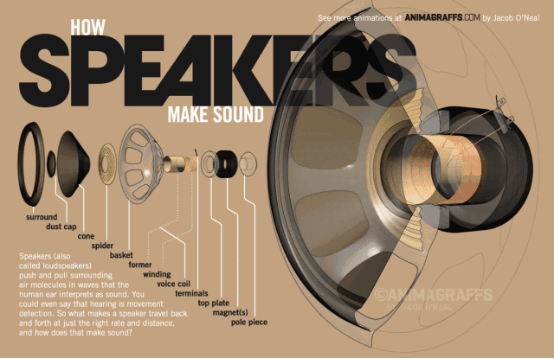
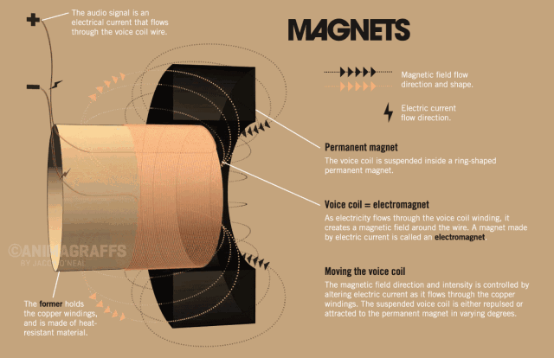
The effect of magnet performance on the quality of speaker sound output In the case of the same magnet volume and the same voice coil, the magnet performance has a direct effect on the quality of speaker sound:
1. the greater the magnetic flux density (magnetic induction strength) B of the magnet, the stronger the thrust acting on the diaphragm.
2. The greater the magnetic flux density (magnetic induction strength) B, the greater the relative power and the higher the relative SPL sound pressure level (sensitivity). Headset sensitivity is the headset input 1mw, 1khz sine wave, the headset can emit sound pressure level. The unit of sound pressure is dB (decibel), the greater the sound pressure, the greater the volume, so the higher the sensitivity, the smaller the impedance, the easier the headset sound.
3. magnetic flux density (magnetic induction intensity) B the greater the total quality factor of the speaker Q value is relatively low. Q value (qualityfactor) is a set of parameters that refers to the speaker damping coefficient, of which Qms for the mechanical system of damping, reflecting the speaker in the movement of the various components of the absorption and consumption of energy. Qes for the electric power system of the damping, mainly embodied in the voice coil DC resistance to the consumption of electric energy; Qts Qts is the total damping, associated with the above two Qts = Qms * Qes / (Qms + Qes).
4. The greater the magnetic flux density (magnetic induction) B, the better the transient. Transients can be interpreted as a “fast response” to a signal, with a high Qms. Good transient response headphones should respond immediately to the signal, the signal stops on the crunch, never dragged. Such as: especially the drums and larger scenes of symphonic music in the lead to the ensemble of the transition part of the most obvious.
How to choose the speaker magnet on the market speaker magnet mainly Alnico, ferrite and neodymium iron boron three categories:
- Alnico is the earliest use of horn magnets, such as the 50s and 60s trumpet horn (known as the tweeter). Generally made of internal magnetic horn (external magnetic can also be used). The disadvantage is that the power is smaller, the frequency range is narrower, hard and very brittle, processing is very inconvenient, in addition to cobalt is a scarce resource, alnico price is relatively high. From the cost-effective point of view, the horn magnet selection of alnico is relatively small.
- Ferrite is generally made of external magnetic horn, ferrite magnetic properties are relatively low, need to have a certain volume to meet the driving force of the horn, so it is generally used in the larger volume of audio speakers. The advantage of ferrite is cheap, cost-effective; the disadvantage is that the volume is larger, the power is smaller, the frequency range is narrower.
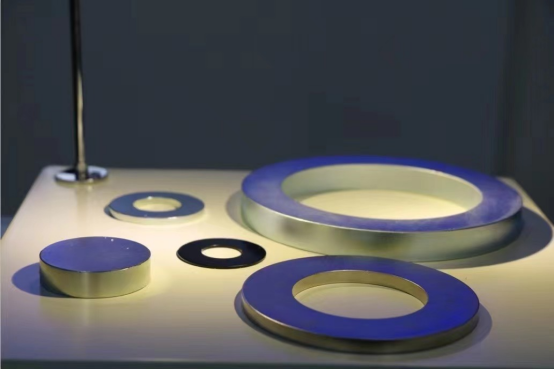
- The magnetic properties of NdFeB are much better than AlNiCo and Ferrite, and it is the most used magnet on speakers, especially high-end speakers. Its advantage is the same magnetic flux under its small size, high power, wide frequency range, the current HiFi headphones basically use this type of magnet. Its disadvantage is that it contains rare earth elements, so the material price is higher.
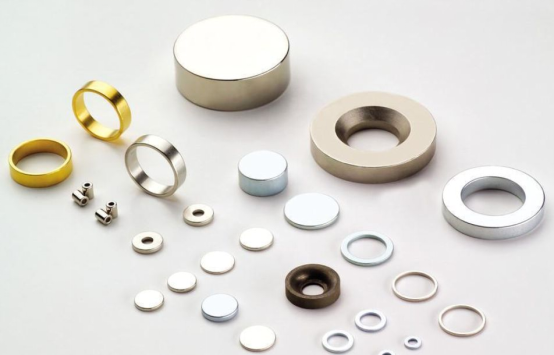
Several factors to consider when choosing speaker magnets
First of all, you need to specify the ambient temperature at which the speakers work, according to the temperature to determine which magnet should be selected. Different magnets have different temperature resistance characteristics and can support different maximum operating temperatures. When the magnet working environment temperature exceeds the maximum operating temperature, there may be magnetic performance attenuation, demagnetization and other phenomena, will directly affect the sound effect of the speaker.
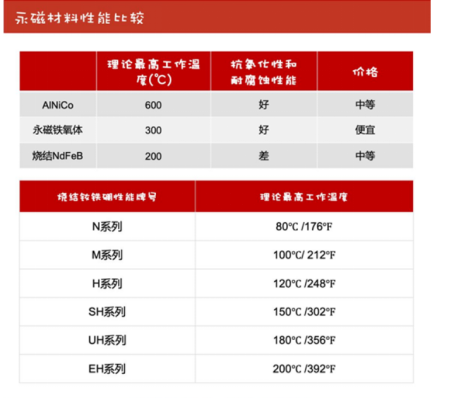
Next, choose a speaker magnet by considering the flux requirements and magnet volume. Some people ask if the horn magnet is the bigger the better the sound. In fact, not, the horn is not the bigger the magnet the better. From the magnet performance on the horn sound output quality, we can find that the magnet flux on the horn sound quality is very large, the same volume, magnet performance: NdFeB>Alnico>Ferrite; in the same flux requirements, NdFeB magnets require the smallest volume, ferrite maximum. The same magnetic material (the same material and the same performance), the larger the diameter, the greater the magnetic susceptibility, the greater the relative power of the speaker, the speaker's sensitivity is relatively higher, the better the transient response. Therefore, you need to comprehensively consider the volume of the horn volume limitations on the magnet and the requirements of the magnet flux performance to determine which magnetic material to choose. Supplementary: Some people ask how many cores of speakers how much magnetism means? We say that the speaker how much magnetic, said the diameter of the magnet in the horn, such as 100 magnetic is to say that the diameter of the magnet is 100mm. said how many speakers core refers to the diameter of the voice coil of the horn, such as 100 core is to say that the diameter of the voice coil is 100mm.











